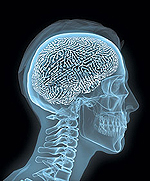Synchronicity: Exploiting the Environs of Consciousness
Friday, October 06, 2006 → by Danieru The brain: that gathered walnut of grey matter, lodged inconspicuously in the skull cavity of each and every one of us. Peer deep enough into these zones of thought; feeling; memory; dreams and each tiny pulse of inherent beauty appears as nothing more than the electrical impulses of furry little neuronal nodes, each playing chaotic games of cause and effect with a handful of neighbours in a never ending stream of activity.
The brain: that gathered walnut of grey matter, lodged inconspicuously in the skull cavity of each and every one of us. Peer deep enough into these zones of thought; feeling; memory; dreams and each tiny pulse of inherent beauty appears as nothing more than the electrical impulses of furry little neuronal nodes, each playing chaotic games of cause and effect with a handful of neighbours in a never ending stream of activity.Sidetracking for a moment the philosophical implications of this mass of electrical chaos one is faced with the insane realisation that thought equals electricity, a fact not lost at the cutting edge of neuroscience:
Recent research has undermined two basic assumptions about how the brain processes information. One is the view of neurons as drones single-mindedly carrying out specific tasks. Cells can be retrained for different jobs, switching from facial expressions to finger flexing or from seeing red to hearing squeaks...An analogy which springs to mind (excuse the pun) is that of music, and more specifically, the discursive patterns inherent in much of what we call music. From Wikipedia:
...Neuroscientists are also questioning whether the firing rate serves as a brain cell's sole means of expression. Rate codes are extremely inefficient.... What counts as a genuine signal is a surge in the firing rate of a cell from, say, 2 to 50 times a second; variations in the intervals between successive spikes in a surge are considered irrelevant. But just as some geneticists suspect that the junk DNA riddling our genomes actually serves hidden functions, so some neuroscientists believe that information may lurk within the fluctuating gaps between spikes. Schemes of this sort, which are known as temporal codes, imply that significant information may be conveyed by just a spike or two... - link
Discursive repetition is "at the level of the phrase or section, which generally functions as part of a larger-scale 'argument'."Yet it is not merely the notes and the combination of these notes which we are interested in here. It would appear, as in the creation of patterns in the brain, that the silence, the gaps between discursive phrases make as much impact on the overall 'argument' of music as the notes themselves. Here we find the character of the piece, in the very aspects of music the composer spent their time avoiding. Creativity in this sense, and consciousness in that of the brain, are as much formed from the lack of activity as they are from its summation.
 There are further implications on the nature of consciousness which result from patterned activity in the brain. Epilepsy has long been known to arise from the synchronisation of groups of neurons in the brain which do not normally interact. As the firing of these neurons increases in chaotic complexity so the epilepsy sufferer will edge closer towards a seizure [ref]. During such attacks consciousness can seem gripped by waves of synchronicity shooting through regions of the sufferer's brain, waves which oftentimes lead to violent loss of control relating to most functions of thought. Here though is where my interest is sparked, for in the seemingly random chaos inherent in these seizures many sufferers have reported discovering portals into alternate realms of consciousness. It seems no coincidence that epilepsy and religious / spiritual visions appear to be linked. From V.S. Ramachandran's 'Phantoms in the Brain':
There are further implications on the nature of consciousness which result from patterned activity in the brain. Epilepsy has long been known to arise from the synchronisation of groups of neurons in the brain which do not normally interact. As the firing of these neurons increases in chaotic complexity so the epilepsy sufferer will edge closer towards a seizure [ref]. During such attacks consciousness can seem gripped by waves of synchronicity shooting through regions of the sufferer's brain, waves which oftentimes lead to violent loss of control relating to most functions of thought. Here though is where my interest is sparked, for in the seemingly random chaos inherent in these seizures many sufferers have reported discovering portals into alternate realms of consciousness. It seems no coincidence that epilepsy and religious / spiritual visions appear to be linked. From V.S. Ramachandran's 'Phantoms in the Brain': "I had my first seizure when I was eight years old," [Paul] began. "I remember seeing a bright light before I fell on the ground, wondering where it came from." A few years later, he had several additional seizures that transformed his whole life.Could synchronicity hold the key to understanding how our minds work? It appears so, and as current research continues so the realms of this 'science of chaos' grow ever wider:
"Suddenly, it was all crystal clear to me, doctor," he continued. "There was no longer any doubt anymore." He experienced a rapture beside which everything else paled. In the rapture was a clarity, an apprehension of the divine - no categories, no boundaries, just a Oneness with the Creator. All of this he recounted in elaborate detail and with great persistence, apparently determined to leave nothing out...."
Some evidence suggests that synchrony helps us focus our attention. If you are at a noisy cocktail party and suddenly hear someone nearby talking about you, your ability to eavesdrop on that conversation and ignore all the others around you could result from the synchronous firing of cells. "Synchrony is an effective way to boost the power of a signal and the impact it has downstream on other neurons," says Terry Sejnowski, a computational neurobiologist at the Salk Institute. He speculates that the abundant feedback loops linking neurons allow them to synchronize their firing before passing messages on for further processing. - link
 Perhaps the religious zeal inherent in so many epilepsy sufferers is a result of this synchronous 'focus'. The control wielded by portions of our brain in turning the chaos of reality into a manageable existence seem to leave these gaps open for our exploration. If the cosmos, in all its infinite complexity, is allowed to disorder the brain so the barriers of consciousness break down to expose a 'spiritual realm' beyond. The question for science to grapple with now is not how does our brain augment reality, but how does it constrict it. If we desire to understand the workings of the brain, to draw its computational outlines, so we should ready ourselves for the arenas of consciousness our minds may be given access to.
Perhaps the religious zeal inherent in so many epilepsy sufferers is a result of this synchronous 'focus'. The control wielded by portions of our brain in turning the chaos of reality into a manageable existence seem to leave these gaps open for our exploration. If the cosmos, in all its infinite complexity, is allowed to disorder the brain so the barriers of consciousness break down to expose a 'spiritual realm' beyond. The question for science to grapple with now is not how does our brain augment reality, but how does it constrict it. If we desire to understand the workings of the brain, to draw its computational outlines, so we should ready ourselves for the arenas of consciousness our minds may be given access to.Could understanding the brain, its synchronicity and its methods of taming chaos give use access to layers of reality long thought to be separated from this world? And, if the answer is yes, are there limits to the kind of manipulation we should put our conscious, finite and mortal minds through?
"There are moments, and it is only a matter of five or six seconds, when you feel the presence of the eternal harmony...a terrible thing is the frightful clearness with which it manifests itself and the rapture with which it fills you. If this state were to last more than five seconds, the soul could not endure it and would have to disappear. During these five seconds I live a whole human existence, and for that I would give my whole life and not think that I was paying too dearly...."
Fyodor Dostoevsky on the nature of his epileptically induced hallucinations
Categories: Science, Weird, Consciousness, Quotes, Ideas, Reality, Nature, Religion, Human
|
|

 Links
Links Subscribe via RSS!
Subscribe via RSS!


 Via Email
Via Email


Post a Comment